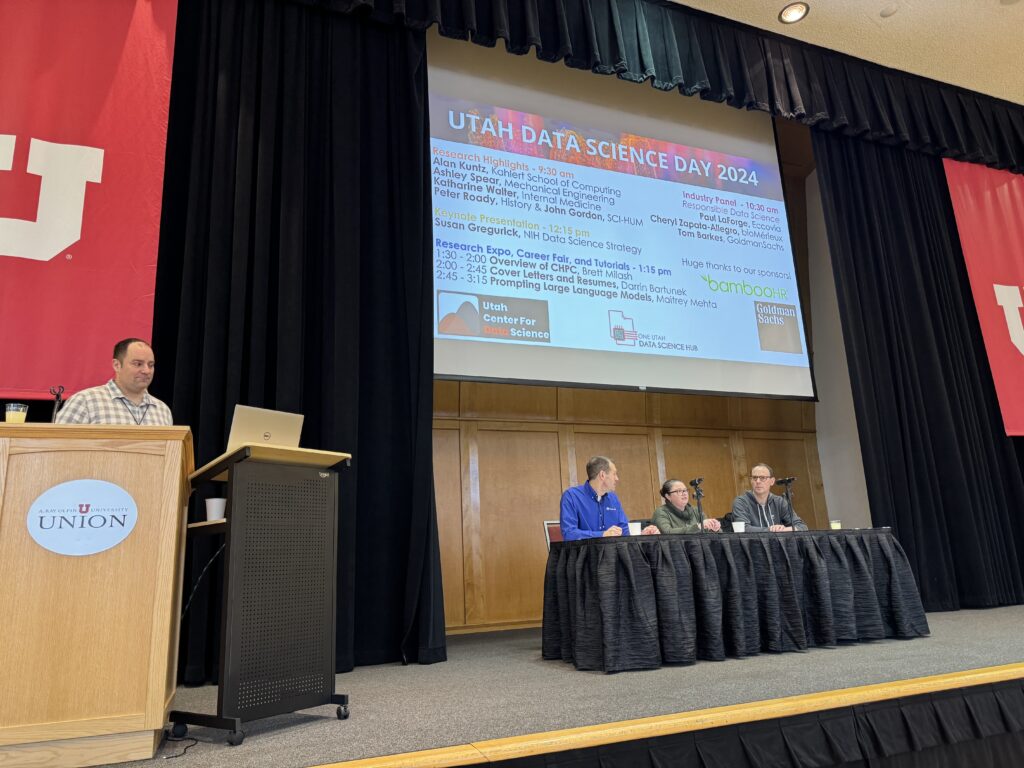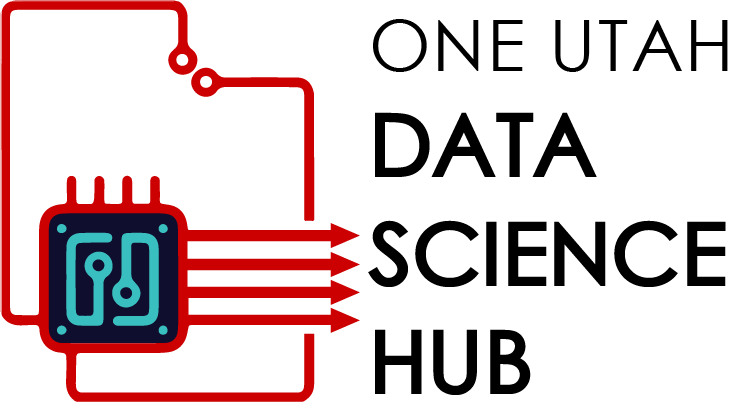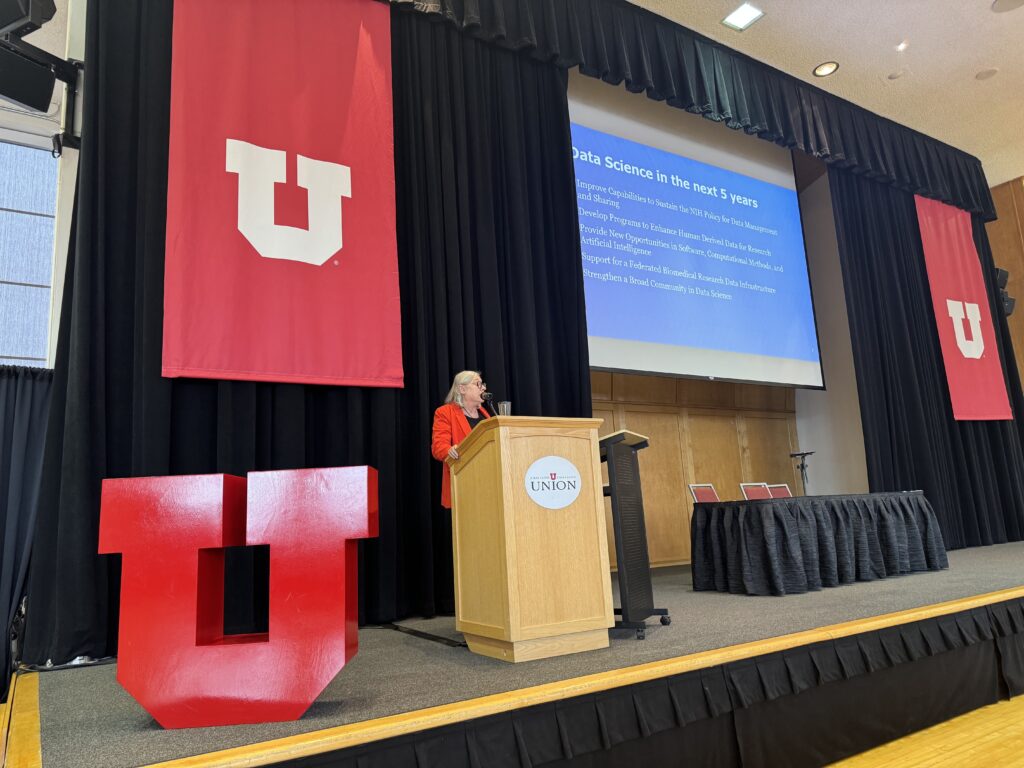By Xoel Cardenas, Sr. Communications Specialist, Office of the Vice President for Research
The University of Utah has always been a step ahead in getting its students prepared in growing fields of study. One that is easily atop the list of growing fields of study is data science. Data scientists help organizations gather, organize, and analyze large amounts of data and information.
With a growing number of businesses, organizations and others needing people to transform data into strategic information, as well as new technologies like artificial intelligence integrating into businesses, the demand for data scientists will continue to grow.
Thanks to its growing data science community, students and faculty — among many other reasons — the U is the best place to study, research and innovate in the field of data science.
DATA SCIENCE IS PART OF OUR EVERYDAY LIVES
Dr. Vivek Srikumar, associate professor in the Kahlert School of Computing at the University of Utah, said data science touches many different aspects of our daily lives, even if we don’t necessarily realize it.
“Machine learning algorithms allow for personalized recommendations for entertainment, on social media feeds and for shopping,” he said. “For example, platforms like Spotify, YouTube and Netflix personalize your recommendations for movies, music, shows or videos based on what you may have watched or listened to in the past.”
Logistics in supply chain management, filtered internet search, and personalized marketing campaigns are just some of the other examples of data science being used around you.
Srikumar said data-driven algorithms make our lives more convenient, comfortable and safe. While data science has many individual and societal benefits, Srikumar said it is important to remember it may also cause harms via privacy concerns and algorithmic bias.
“We must also engage in open and informed discussions to ensure its responsible development and application,” he said. “Data science is still young, and we’re just starting to see its full potential.”
DATA SCIENCE IS A BROAD AND DIVERSE FIELD
Aaron Schindler, an undergraduate student in the data science program at the U, sees data science not necessarily being explained by a single definition is what makes the field that much more appealing.
“Most people will ask me, ‘What is data science?’ when I tell them my major,” said Schindler. “And the fun part is that every time I explain it, my definition changes too. There are so many subfields of data science that you really get the option to choose what interests you the most and specialize in it.”

With so many subfields of data science, both students and faculty get the opportunity to incorporate data science tools to enhance their research work at the U.
“What truly excites me about data science is its perfect blend of technical depth and expansive impact,” said Srikumar. “The sheer variety of applications across diverse disciplines fuels my curiosity and keeps me engaged. But beneath the numerous applications lie foundational algorithmic and mathematical questions that pose technical challenges as well.”
“This dual nature, where intricate technical problems have real-world impact, makes data science such a fun field for me.”
DATA SCIENCE COMMUNITY AT THE U
The growth in the field of data science has without question led to a growth in the data science community at the University of Utah over the past several years.
For Schindler, one of his favorite U data science communities is the Utah Center for Data Science because they hold weekly seminars on various topics from different experienced professionals.
Collaboration is without question what helps make a community strong. At the U, the data science community is passionate about collaborating and is continuously looking for new ways to work together with different programs, departments, colleges or clubs.
“Basically all my data science collaborations at the U have been interdisciplinary, which has been fantastic,” said Brenna Kelly a first-year Ph.D. student in Population Health Sciences. “While my background is in geography and population health, I’ve been able to work with OB-GYNs, an ecologist, and faculty from atmospheric science, psychiatry, and sociology. I think the best work happens when people with different backgrounds tackle a problem together.”
Kelly thinks we’ll see more interdisciplinary collaborations in the future, adding that the One Utah Data Science Hub has formally established a community that a lot of researchers and students were seeking. She added that what’s great about the data science community at the U is that it’s so active.

“The One Utah Data Science Hub was launched less than two years ago by the Office of the Vice President for Research, yet I have witnessed immense growth in the community from the added infrastructure of the hub,” noted Penny Atkins, associate director of the One Utah Data Science Hub. “In addition to events like Utah Data Science Day, the One Utah Data Science Hub sponsors research through a seed grant program, provides regular updates of curated funding opportunities and events, and has hosted events for networking and idea sharing. Through these activities, the hub really aims to empower innovation in data science and provide opportunities for multi-disciplinary and data-enabled research.”
From a faculty perspective, Srikumar said the data science community pervades the University of Utah, adding he’s been lucky to have several fruitful collaborations at the U.
“As a computer scientist specializing in natural language processing and machine learning, I’ve had the privilege of collaborating with researchers in diverse fields like psychotherapy, linguistics, mechanical engineering, and medicine,” he said.
One long-running collaboration Srikumar has had over the years involves the application of artificial intelligence (AI) in mental health counseling. It’s an area where he believes technology can make a real difference, especially given that the lack of readily available mental health support can be challenging for individuals and communities.
CELEBRATING DATA SCIENCE
In January, the Utah Center for Data Science and the One Utah Data Science Hub organized and held the annual Utah Data Science Day on the U campus. Students and faculty from several academic colleges and departments gathered at the Union Building to take part in the event.

Some of the highlights of Utah Data Science Day 2024 were a panel discussion, faculty research highlights, an industry expo, and tutorials. The day’s event culminated with a keynote talk from Dr. Susan Gregurick, Associate Director for Data Science and Director of the Office of Data Science Strategy (ODSS) at the National Institutes of Health (NIH).
Schindler said his biggest takeaway from Utah Data Science Day that he would think is relevant to everyone is just how integrated so many fields are with data science.
“These talks illustrated how data science is shaping the future of our health, environment, and even the way we understand the past, making it a field with something for everyone,” Srikumar added.
DEDICATED STUDENTS AND FACULTY AT THE U
When asked what they’d want current or prospective students to know about data science at the U, both Kelly and Schindler said it’s the faculty.
“The University of Utah’s data science faculty is what I consider the top of their fields,” Schindler said. “The curriculum they have designed for us is not only wide ranging in topics but it also gives us the information and experience to be useful immediately after graduation.”
“The U has connected me with the mentors who shaped me,” said Kelly. “I’ve been able to work in data science because of the many opportunities I’ve been given by faculty at the U.”
What’s next for data science’s growing research at the U? The future is bright and the possibilities for innovating are many.
“Data science and artificial intelligence are already pervasive across the U. But this is just the beginning,” said Srikumar. “The possibilities are as diverse as the intellectual disciplines across the U. And the impact doesn’t stop with research.”
“For our students who are studying these fields, this presents exciting possibilities. They will be the architects of our new data-driven future and will build new innovations that we can’t even imagine today.”
To get involved with the One Utah Data Science Hub or other aspects of the data science community at the U, visit the One Utah Data Science Hub website or reach out to them directly via email.
“Data science and artificial intelligence are already pervasive across the U. But this is just the beginning. The possibilities are as diverse as the intellectual disciplines across the U… For our students who are studying these fields, this presents exciting possibilities. They will be the architects of our new data-driven future and will build new innovations that we can’t even imagine today.”

